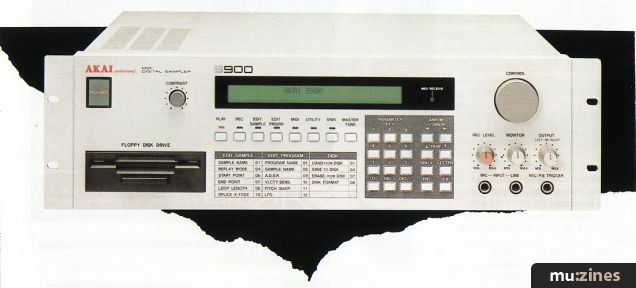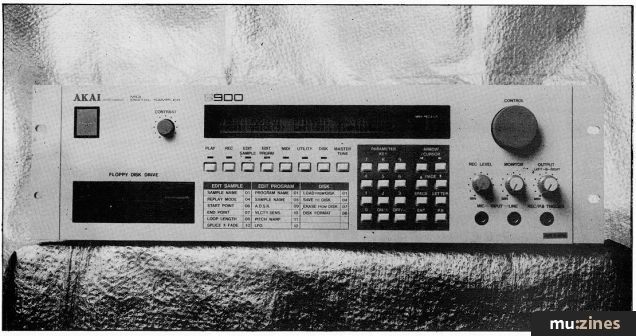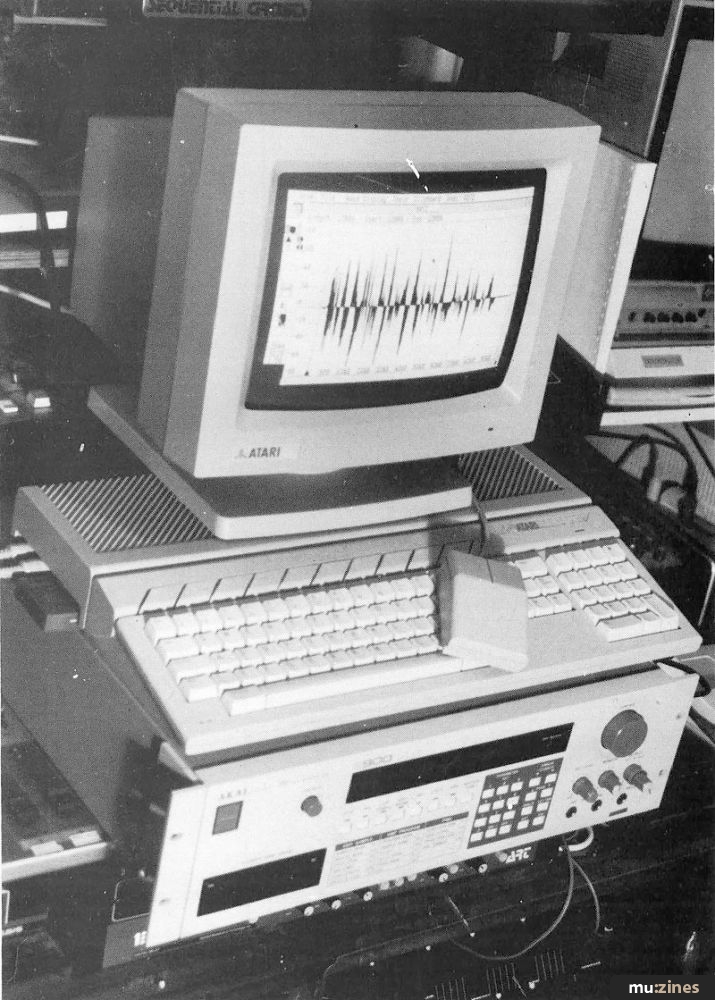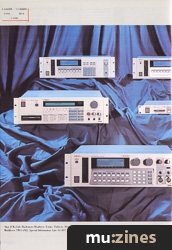Magazine Archive
Home -> Magazines -> Issues -> Articles in this issue -> View
Akai S950 | |
Article from Home & Studio Recording, March 1989 | |
The successor to Akai's industry standard S900 hits the streets.
Akai's S950 isn't so much a new model between the S900 and the S1000 but a successor to the S900 itself.

Akai introduced the S900 in 1986 with the intention that it should supercede the S612. It did far more than that, finding its way into large and small studios alike. After nearly three years during which various updates have occurred, Akai obviously feel that it is now time to consolidate their position, hence the demise of the S900 and the S700/X7000, and the appearance of the S950.
How does it differ from its nearest relative, the S900? A couple of cosmetic changes have taken place on the front panel, namely that the keypad is now blue/grey and the original knobs have been replaced by the S1000 versions. The disk drive is now of the type that can use either standard DS/DD disks or the quad density (marked as 'HD') variety which will hold twice as much information, and are capable of reading the 16-bit S1000 samples by, I presume, only reading the first 12 bits of data. The quality of these tends to be excellent and it is certainly worth borrowing some S1000 disks and converting them onto the S950.
While the S900 memory was fixed at 750 Kbytes, the new machine has the same standard memory but can be expanded by unscrewing the bottom panel and fixing in either one or two EXM-006 boards, giving a maximum of 2,250 Kbytes which means that data from three S900 disks can be loaded up simultaneously. To this end, the maximum number of samples has been increased to 99, the keygroups to 198 and, additionally, the sampler can continue to play while loading up new programs/samples so long as the samples for the program being used are already in memory.
Practically all of the version 2.1 software updates have been placed in ROM so that they are in residence as soon as the S950 is powered up and all extra pages pertaining to hard disk are also implemented. The maximum sampling rate has been increased to 48kHz and the existence of the optional IB-105 interface board for hard disk/CD/R-DAT means that samples can be transferred digitally into the S950 from the relevant source. The increased sampling rate gives a maximum bandwidth of 19,200Hz and example sampling times as in the table below:
| Sampling Rate | Audio Bandwidth | Basic System | One EXM-006 | Two EXM-006's |
| 25 kHz | 10 kHz | 19.00 secs | 39.97 secs | 60.94 secs |
| 40 kHz | 16 kHz | 11.88 secs | 24.98 secs | 38.08 secs |
| 44.1 kHz (CD) | 17.64 kHz | 10.77 secs | 22.66 secs | 34.55 secs |
| 48 kHz (R-DAT) | 19.2 kHz | 9.89 secs | 20.82 secs | 31.74 secs |
The only major function update is time stretching, a simplified version of that intended for the S1000. The idea is to keep the pitch of a sample constant while altering the length and is based on digital harmonising. A sample starts life as 100% and can be stretched up to 999% or shrunk down to 1% (although values of below 30% tend to have dubious musical connotations). The delay factor (D-time) can be user set and defaults to a figure of 1,000 - high values of D-time lead to multiple echoes while small values give a ring modulator type of effect.
A constant pitch sample is called a 'mono' sample and 'Auto-D' can be used to provide a suitable D-time value, while a variable pitch sample is termed 'poly' and a D-time value of between 800 and 1,400 is usually about right. As a new sample is created, the process can take up to 91 seconds to perform dependent on the length of the sample and whether mono or poly is selected. Sound quality of the new sample is pretty well on a par with the original and on small percentage changes the results are very good.
"The only major function update is time stretching, a simplified version of that intended for the S1000."

Velocity cross-faded (X-Faded) samples have disappeared without trace. This is the ability to take two sounds, sampled as 'soft' and 'loud', and to fade one in as the other fades out depending on the playing velocity. This particular facility was of limited value on the S900 as two samples had to be taken of each sound and the fixed memory meant that multi-sampling was severely restricted. As the S950 is memory expandable, the omission of the function is a mystery and, of course, any other techniques which require a x-fade pair have also vanished - velocity x-fade time skew and mix to mention but two. As many S900s are used as super drum machines with the ASK90 drum trigger unit attached, it comes as a surprise to learn that this interface is not compatible with the S950. The space on the rear panel has now been taken up by the hard disk board and should this particular facility still be required, the ME35T will have to be bought which is an eight-input audio trigger to MIDI unit acting in much the same way as the ASK90 (see H&SR review November 1988). A final point worth mentioning here is that you can no longer format a disk and save the memory from page 4 of the disk menu, the disk has to be formatted first.
Is everything in the garden rosy? Akai appear to have decided against being adventurous. While other sampler manufacturers have plumped for larger internal memory and higher polyphony as standard (eg Roland S550), Akai have kept the former the same, but expandable. The latter is still eight notes with individual monophonic outputs. While this may be fine if the S950 is to be used solely for drums, it is less satisfactory if different instruments are to be used from the same program. For instance, with a memory capacity of 99 samples, it is now conceivable to have fully multi-sampled strings, brass and piano co-resident in the same program and yet it is impossible to assign them to polyphonic separate outs in order to run them into individual channels on a mixing desk.
Having added a static voltage controlled filter to the version two software upgrade on the S900, it would have been nice to see resonance and feedback controls added to convert this into a dynamic filter of more useful proportions.
Conclusion
It would have been nice to have seen a 2.25 Megabyte sampler with 16-note polyphony bearing the name 'S950' but the price tag would probably have been nearer to £2,000. This would have kept the status quo regarding second-hand S900s, which have suffered an inevitable resale price collapse, but would then have been a little close for comfort to the S1000 so perhaps Akai got it right. The S950 shared the ease of operation which has been the hallmark of Akai samplers and though still 12-bit, the sound quality really is very good. There are omissions, but then this isn't Akai's top of the range instrument anymore and it's up to the individual user to decide what can and can't be lived without.
I really see the S950 as an up-to-date S900 which has some significant improvements over its predecessor yet the retail price is still realistic.
The S950 costs £1,399 inc VAT.
(Contact Details)
Also featuring gear in this article
Featuring related gear
Akai S900 MIDI Digital Sampler
(IT Jul 86)
Akai S900 Revisited
(SOS Oct 87)
Akai S900 Sampler - SamplerCheck
(IM Jul 86)
Akai S900 Sampler
(EMM Jul 86)
Bits & Pieces - How To Upgrade Your Akai S900
(SOS Dec 88)
Eat your heart out PPG! - Akai S900 Sampler
(SOS Jul 86)
Getting The Most From... Mono Mode (Part 3)
(EMM Oct 86)
Sampling An Akai - Akai S900 Sampler
(HSR Sep 86)
Browse category: Sampler > Akai
Publisher: Home & Studio Recording - Music Maker Publications (UK), Future Publishing.
The current copyright owner/s of this content may differ from the originally published copyright notice.
More details on copyright ownership...
Review by Vic Lennard
Help Support The Things You Love
mu:zines is the result of thousands of hours of effort, and will require many thousands more going forward to reach our goals of getting all this content online.
If you value this resource, you can support this project - it really helps!
Donations for April 2024
Issues donated this month: 0
New issues that have been donated or scanned for us this month.
Funds donated this month: £7.00
All donations and support are gratefully appreciated - thank you.
Magazines Needed - Can You Help?
Do you have any of these magazine issues?
If so, and you can donate, lend or scan them to help complete our archive, please get in touch via the Contribute page - thanks!
















